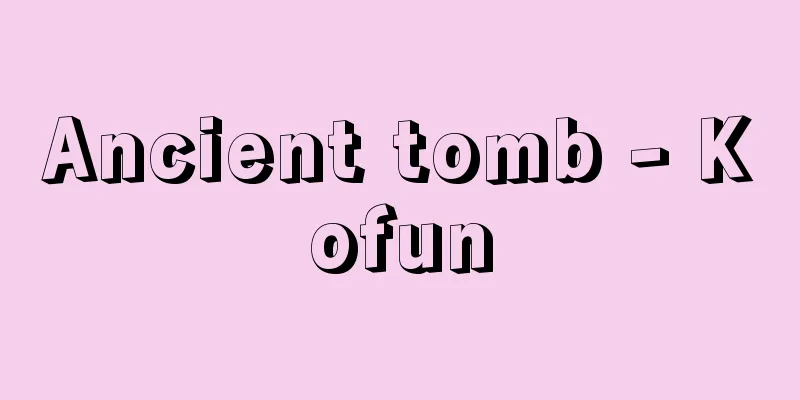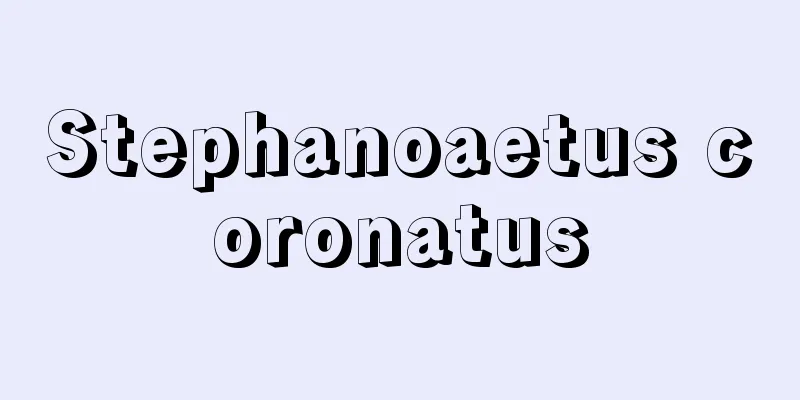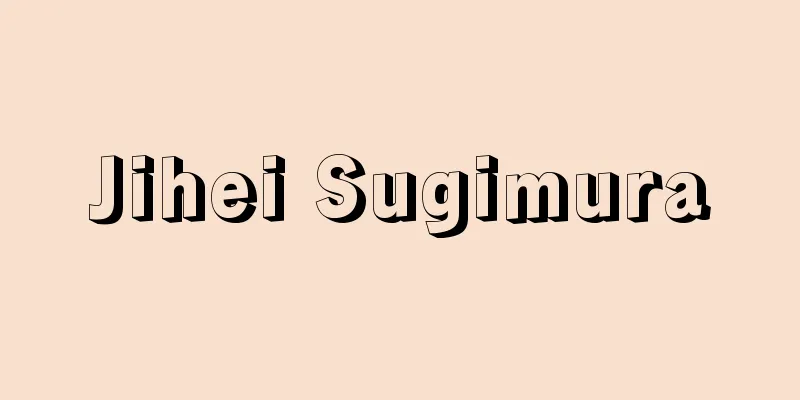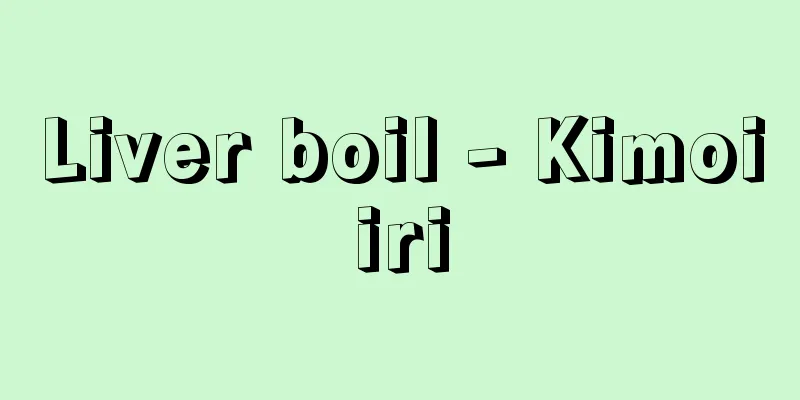Ancient tomb - Kofun

DefinitionGenerally, it means an ancient tomb, but in Japanese archaeological research, the word is used in a more limited way. The character "fun" means a grave made of piled up earth, so even if the character "ko" simply means an older era, piled-up earth tombs from the Middle Ages and early modern times are not called kofun. They are called medieval or early modern tombs. Therefore, kofun refers to high mound tombs that appeared in ancient Japan, especially at the end of the Yayoi period in the latter half of the 3rd century AD, and were built by the end of the 7th century. Regardless of their size, kofun have mounds of piled earth or stones and burial facilities for the remains inside. They also generally have grave goods attached to them, regardless of their quality or quantity. This burial facility for the remains is called the inner body or inner structure of the kofun. Some kofun have terraces on the mound as external facilities, making them two or three tiered. There is a tendency for terraces to be more prevalent among large kofun. Some kofun are decorated with cylindrical haniwa clay figures and figurative haniwa clay figures of objects, people, animals, etc. on the inner and outer banks of the mound and the moat that surrounds it. Roofing stones are laid on the sloping sides of the mound, which is thought to have begun to prevent the soil from collapsing and to make the kofun into sacred places. The construction of a kofun requires a considerable amount of manpower and labor, and is a large-scale civil engineering project, so we can assume that there was a person of a high social status who was able to concentrate and manage labor. The grave goods placed with the remains can also be interpreted as concrete expressions of the financial and power of the person buried in the kofun. The kofun were a generous burial method for the dead, and not just anyone was buried in them; they were graves for specific individuals, not for the general public. In other words, they were graves for political figures or rulers who reigned over society, and while they were graves in themselves, they were also a kind of historical and social monument. Therefore, the appearance of kofun signified the appearance of political figures and the transformation of society into a political one, and so the period in which kofun were built is called the "Kofun period," as distinguished from the previous Yayoi period. [Hatsue Otsuka] Types of burial moundsJapanese kofun (tumuli) display the greatest diversity of burial mound forms in the ancient East Asian world. [Hatsue Otsuka] Circular tumulusThe most common type of tumulus is the circular one. The so-called "late period tumulus" such as Takamatsuzuka tumulus in Nara Prefecture, built around the end of the 7th century, has a rounded top like a clay dumpling, but generally it is a truncated cone-shaped tumulus with a flat top. There are about 250,000 tumuli distributed throughout the country, and about 95% of them are thought to be circular. Most of the circular tumuli are about 10 to 20 meters in diameter, 2 to 3 meters in height, with a slope of about 20 to 25 degrees, and usually have a moat several meters wide and about 1 meter deep. Maruhakayama tumulus in the Saitama tumulus group in Gyoda City, Saitama Prefecture, is the largest circular tumulus in Japan, with a diameter of about 105 meters, a height of 18.9 meters, and a moat width of 40 meters. There are kofun tombs that have roofing stones and haniwa and kofun tombs that do not. Roofing stones and haniwa are not recognized in the final period of kofun. [Hatsue Otsuka] Scallop-shaped burial moundScallop-shaped tumuli are circular tumuli with a low, short protrusion, and are so named because their planar shape resembles a scallop shell. In the 1930s (early Showa period), when this short protrusion was understood to be the underdeveloped front part of a keyhole-shaped tumuli, it was thought that scallop-shaped tumuli were related to the origin of keyhole-shaped tumuli. It is now understood that in the 5th century, the Yamato government began to impose strong political restrictions on local chiefs, which restricted the construction of keyhole-shaped tumuli and forced people to switch to the construction of scallop-shaped tumuli. Until now, the largest scallop-shaped ancient tomb in Japan was believed to be the Otomeyama Tomb in Kawai Town, Kitakatsuragi County, Nara Prefecture, which is 130 meters long and 15 meters high, but in 1998, it was discovered that the Osahozuka Tomb in the Saitobaru Tomb Group in Saito City, Miyazaki Prefecture, is 154.6 meters long and 19.1 meters high, and this was determined to be the largest example in Japan. The largest example in the eastern part of the country is the Nyotaisan Tomb in Ota City, Gunma Prefecture, which is 106 meters long, 7 meters high, and has a surrounding moat. [Hatsue Otsuka] Square tombSquare tombs have mounds with a square or slightly rectangular plan, and rectangular tombs are becoming known. In the 1930s, Umehara Sueji's collection of square tombs nationwide contained only 32, but by 1980, the number had exceeded 2,000 nationwide. Masuyama Kofun in Kashihara City, Nara Prefecture, is the largest square tomb in Japan, with a side of 85 meters and a height of 15 meters. In the eastern part of the country, Iwaya Kofun in Sakae Town, Inba County, Chiba Prefecture, is a large square tomb with a narrow moat, with a side of 80 meters and a height of 12.4 meters. There are two types of square tombs: the 4th and 5th century type and the 6th and 7th century type. In the former type, the direction of one side of the mound often does not match the east-west-north-south direction, while in later Kofun examples, the direction of each side is relatively consistent with the direction. The tombs of Empress Yomei and Empress Suiko are known as square tumuli. [Hatsue Otsuka] Rounded tomb with lower sectionOne form that is noteworthy in relation to square tombs is the circular-top tomb, a unique one. The lower level of the mound is square with a circular top, but there are few similar examples. Known examples include the Tenno Tenno Mausoleum in Yamashina Ward, Kyoto City, Yamahata No. 2 Tomb in Higashi Osaka City, Karato Tomb in Sakurai City, Nara Prefecture, and Miyazuka Tomb in Kumagaya City, Saitama Prefecture. Ishibutai Tomb in Asuka Village, Nara Prefecture also has an exposed horizontal stone chamber, but it is suspected to have been a circular-top tomb. [Hatsue Otsuka] Keyhole-shaped tumulusKeyhole-shaped tumuli are said to be a uniquely Japanese form of tomb, and were named after Gamou Kunpei in his Sanryōshi (published in 1808) during the Edo period. They have a circular main mound with a square platform on one side. Keyhole-shaped tumuli appeared with the start of the Kofun period, disappeared in the Kinki region by the latter half of the 6th century, and continued to be built in various parts of eastern Japan until the mid-7th century. After construction of keyhole-shaped tumuli ceased, square and circular tumuli continued to be built until the end of the 7th century, and in the eastern part of Japan until the beginning of the 8th century. From a national perspective, it is believed that keyhole-shaped tombs appeared in the Kinki region around 260-280 AD, and that they had ceased to be built in eastern Japan by around 650. This is probably related to the degree to which the political control of the Yamato government had spread to various regions. Therefore, the characteristics of keyhole-shaped tombs, which changed over time, are steadily reflected in the changes in keyhole-shaped tombs not only in the Kinki region but also throughout the country. This type of keyhole-shaped tomb was the preferred tomb shape of the successive great kings of the Yamato government, which was established with the Kinai region at its core. Most of the tombs of emperors and empresses from the late 3rd century to the 7th century that are under the jurisdiction of the Imperial Household Agency are keyhole-shaped tombs, and they serve as an important chronological yardstick for research into the Kofun period. A chronology of kofun is carried out by comparing and examining important aspects of the kofun, such as the location of the mound of a keyhole-shaped tomb, the characteristics of its form, changes in its internal structure and grave goods, and the distinctive arrangement of haniwa clay figures, in order to clarify the changes in keyhole-shaped tombs. From around the mid-4th century, keyhole-shaped tombs have had a "tsukuridashi" protruding outward from the narrowest part. Although the meaning of the tsukuridashi is still unclear, it coincides with the appearance of auxiliary mounds and associated burials, and it is thought that this spot had an important significance as a place for funeral rites outside the mound of a keyhole-shaped tomb and as a place for the execution of kofun rituals. [Hatsue Otsuka] Keyhole-shaped tombA keyhole-shaped tomb has a rectangular front section attached to a square main mound; in addition to square rear sections, there are also rectangular and trapezoidal examples. The changes in the front section are in line with those of keyhole-shaped tombs. Compared to keyhole-shaped tombs, there are very few of them, with only about 450 having been discovered nationwide to date. Moreover, most examples of keyhole-shaped tombs were built between the 3rd and 5th centuries, with relatively few examples belonging to the Late Kofun period from the 6th century onwards. Keyhole-shaped tombs are distributed from Miyagi and Yamagata prefectures in the Tohoku region to the three prefectures of Fukuoka, Saga and Nagasaki in northern Kyushu in western Japan. Among the ancient tombs that the Imperial Household Agency has determined to be imperial tombs, not a single one is a keyhole-shaped tomb, and there are only two examples of tombs that have been used as reference sites for imperial tombs: the Shinyama Tomb in Koryo-cho, Nara Prefecture, and the Kamezuka Tomb in Nakanoto-cho, Kashima-gun, Ishikawa Prefecture. In terms of size, the Nishiyama Tomb in Tenri City, Nara Prefecture is the largest, with a total length of 180 meters. [Hatsue Otsuka] Both sides have medium-sized circular tombsBoth medium-sized circular tombs are unique in that they have a front-like protrusion on the opposite side of the main axis of the keyhole-shaped tomb, and examples of this include Nekozuka Tomb in the Iwaseoyama Tomb group in Takamatsu City, Kagawa Prefecture, and Kushiyama Tomb in Tenri City, Nara Prefecture. [Hatsue Otsuka] Both sides have central tombsThere are also very few examples of what are called double-sided central tumuli, which are tumuli with a front-like platform on the opposite side of the main axis of a keyhole-shaped tumulus. The only such example is the Akeai tumulus in Ano-cho, Tsu City, Mie Prefecture. [Hatsue Otsuka] Double-circular tombIt is a combination of two circular tombs, and can also be called a circular front tomb. Double circular tombs are not unique to Japan; rather, they are commonly found in the Gyeongju region of the Korean peninsula, where they are called gourd-shaped tombs. Although an extremely rare example in Japan, the Kanayama Tomb in Kanan Town, Osaka Prefecture, which has a horizontal stone chamber and a house-shaped stone coffin in the main part of the interior, is known. [Hatsue Otsuka] Octagonal TombOctagonal tombs have only recently come into question. Some believe that the planar shape of the mound is octagonal, and that this form was strongly influenced by political thought based on the ancient Chinese view of the universe and the worship of heaven and earth. In addition to the Nakaoyama Tomb in Asuka Village, Nara Prefecture, and the joint mausoleum of Emperor Tenmu and Jito, their existence in eastern Japan from the 7th century is also known, including the Inarizuka Tomb in Tama City, Tokyo, the Mitsuya Tomb in Yoshioka Town, Gunma Prefecture, and the Kyozuka Tomb in Ichinomiya Town, Fuefuki City, Yamanashi Prefecture. [Hatsue Otsuka] Underground cave tombsWhile a burial mound is the general form of kofun, there are some kofun that have been treated in an exceptional way. One of these is known as an underground tunnel tomb or underground kofun. A vertical shaft is dug into the flat ground on the plateau, and the burial chamber is created by digging further sideways from the bottom. The ceiling of the burial chamber is modeled after a hipped roof or gabled roof, and is commonly seen in Miyazaki and Kagoshima prefectures. It is highly likely that they were built throughout the entire Kofun period, from the 5th century onwards. [Hatsue Otsuka] Cave tombThey are called horizontal cave tombs or horizontal cave tombs, and are sometimes called horizontal cave tumuli. Tombs dug into the slopes of hills or plateaus made of relatively soft rocks such as tuff and sandstone are also an exception to the rule of kofun. They do not have a burial mound at all and do not fall under the concept of a kofun, but their internal structure resembles that of a horizontal cave-type stone chamber, and may have an entrance passage, a burial chamber, and a vestibule. Horizontal cave tombs are strongly influenced by the region, and show complex aspects such as a high coffin base and an interior that resembles the ceiling of a house. The construction of tunnel tombs coincides with the construction of tunnel-type stone chambers, and some of them contained cremated remains. They were used from the late Kofun period through the Nara period. Dozens, sometimes hundreds, of tunnel tombs were built in one area, and they represent the characteristics of communal cemeteries for local communities, mainly in the 6th and 7th centuries. [Hatsue Otsuka] Chronology of the ancient tombsIn addition to differences in the shape of the tombs, the internal structure of the tombs (such as stone chambers, stone coffins, and wooden coffins) and changes in the style and combination of the grave goods (such as mirrors, accessories, weapons, military equipment, horse equipment, Hajiki pottery, and Sueki ware) are analyzed to determine the construction period and organize a chronological system. When dividing tombs into three periods, early, middle, and late, the early period has been considered to be in the 4th century, the middle period to the 5th century, and the late period to the 6th and 7th centuries. In contrast, a more detailed chronological view has also been used to trace the detailed changes in tombs from around the 3rd century to the 7th century. This method divides tombs into two periods, early and late, with the early period being divided into four sub-periods and the late period being divided into three sub-periods, for a total of seven sub-periods. The following will be written based on this division into seven sub-periods. The internal structure of the Pre-I period is notable for its vertical stone chambers encasing split-bamboo-shaped wooden coffins and assembled wooden coffins, while the Pre-II period, in the latter half of the 4th century, features clay coffins, charcoal coffins, split-bamboo-shaped stone coffins, and boat-shaped stone coffins. The large number of mirrors buried as grave goods was limited to imported mirrors from China in the Pre-I period, while imitation mirrors appeared in the Pre-II period. In the Pre-III period, the keyhole-shaped tombs became larger, and the production and use of iron weapons and armor increased, as evidenced by the large number of iron ingots unearthed. The military power of the Yamato government around the 5th century was strengthened. The Pre-IV period was a period of change in the latter half of the 5th century, when advanced groups of people and technologies in various fields, such as burial systems, ceramic technology, craft technology, and horse riding customs, from the Korean Peninsula influenced Japan. Horizontal stone chambers appeared, and this new burial method spread throughout the country in the first half of the 6th century. Sue ware production and the custom of horse riding also expanded rapidly. Mirrors and jasper bracelets, which were once considered magical treasures, decreased in number or disappeared, and lavishly decorated swords, glittering gold earrings, crowns, decorative sandals, and belt accessories, which were symbols of recognition of the chief's position and social status, were added to the grave goods. An iron sword with a gold inlaid inscription of 115 characters was excavated from the gravel coffin of the Inariyama Kofun in Gyoda City, Saitama Prefecture. The name of the Great King Wakatakeru, who is presumed to be King Wa Bu (Emperor Yuryaku) and who appears in the "Song Shu Wakokuden," as well as the date Shingai (471), provide archaeological evidence that the leader of the Pre-IV Period Kofun tombs in Musashi, eastern Japan, played a part in an extremely powerful military group under the great king of the Yamato government. In the Late Kofun Period, from the 6th to 7th centuries, keyhole-shaped tombs generally began to shrink. In advanced regions, a tendency towards clustered tombs had already begun to appear from the 5th century, but clustered tombs appeared in various places from the Late I to Late II periods. Clustered tombs are small circular and square tombs distributed in a relatively small area. These tombs show homogeneous content and were built in a similar time period, indicating an increase in the number of tombs built in one period, and a trend towards more generalized hierarchical structure as the number of buried persons increased. The structure of the horizontal-hole stone chamber allows the entrance of the passageway to be opened and closed each time a burial is performed, making it possible to carry out multiple burials. Eleven remains are buried in the horizontal-hole stone chamber of Oyabu Kofun in Higashiosaka City, Osaka Prefecture, and it is likely that it was used as the tomb of a prominent family member within the group. The structure of the tunnel-type stone chambers also changed, and house-shaped and box-shaped stone coffins became popular. In the Late II period, tunnel tombs were actively built in various places, and many grave goods were found in the graves of Sue ware and Haji ware. Ceramic coffins appeared in the Late II period, in the first half of the 7th century, and no keyhole-shaped tombs were built in the Kinki region. Keyhole-shaped tombs were built in the Kanto and Tohoku regions until the first half of the 7th century. However, in the second half of the 7th century, the construction of keyhole-shaped tombs and the arrangement of haniwa on burial mounds ceased. This may be due to a major change in the nature of the kofun, but the progress of the Ritsuryo system as a centralized state probably forced a major change in the kofun themselves. In recent years, a method has been adopted to classify keyhole-shaped tombs into periods 1 to 10 based on the changes in their shape. [Hatsue Otsuka] Late KofunIn terms of the time division of the Kofun period, there is no consensus as to whether the tombs from the final stage of the Late Kofun period should be considered as terminal-stage tombs or as a limited number of tombs that were built after the formation of cluster tombs had ceased. They are generally understood to be tombs from the final stage of the Late Kofun period. Interest in terminal-stage tombs has increased since the discovery of the Takamatsuzuka Tomb in Asuka Village, Nara Prefecture, discovered in 1972 (Showa 47), which has colored murals of the four gods and groups of people, as well as a gold leaf star constellation, and the discovery of a mural of the four gods and an astronomical chart at the Kitora Tomb in Asuka Village in 1998 (Heisei 10). In the Kinai region from the late 7th century to the early 8th century, the construction of ancient tombs was generally not seen at all, and instead, elaborately constructed horizontal-entrance stone coffins, plaster-coated cut-stone stone chambers, lacquered wooden coffins, and kyocho coffins were used. The Tenmu and Jito joint mausoleum tomb, Nakaoyama Tomb, Kengoshizuka Tomb, Midoro Tomb, Marukoyama Tomb, and Tsukamyojin Tomb in the Asuka region of Nara Prefecture are considered typical examples of late-period tombs. [Hatsue Otsuka] Planning of the construction of the ancient tombIn keyhole-shaped tumuli, the left and right sides of the central axis are similar in shape, and based on the correlation between the morphological changes in the front and back mounds, it is speculated that there were basic design standards for the construction of tumuli. The construction of huge tumuli, including their surrounding moats, must have required highly developed civil engineering designs, labor management and organizational procedures for mobilizing large numbers of workers. The labor force and technology concentrated in the construction of tumuli can be used as a barometer of the development of Japan's Kofun period. [Hatsue Otsuka] "World Archaeology Series: Japan III, The Kofun Period (1960, Heibonsha)" ▽ "Japanese Archaeology IV, The Kofun Period, Vol. 1 (1967, Kawade Shobo)" ▽ "Research on Japanese Kofun Tombs, by Saito Tadashi (1961, Yoshikawa Kobunkan)" ▽ "Thoughts on Kofun Culture, by Kobayashi Yukio (1976, Heibonsha)" ▽ "Collection of Essays on Late Kofun Tombs, by Mori Koichi (1973, Hanawa Shobo)" ▽ "Encyclopedia of Japanese Kofun Tombs, edited by Otsuka Hatsushige et al. (1989, Tokyodo Publishing)" [References] | | |©Shogakukan "> Types of burial mounds The circular tumulus has a diameter of about 37m and a height of about 8m. Because no archaeological investigations have been carried out, the internal structure and construction date are unclear, but it is estimated to have been built in the late Kofun period (late 6th century to early 7th century). The giant black pine tree "Happo Nirami no Matsu", which covered the entire tumulus, has died in recent years and can no longer be seen. Nationally designated historic site Iwaki City, Fukushima Prefecture ©Seishohmaru "> Kabutozuka Tomb Shimozamuraizuka Tomb is one of two keyhole-shaped tombs also known as Kurumazuka. It is known as an ancient tomb that was excavated in 1692 (Genroku 5) by order of Tokugawa Mitsukuni, lord of the Mito domain, along with Kamizumazuka. It is 84m long and 48m wide at the rear. The pine trees on the mound were planted at the time of Mitsukuni's excavation to prevent the pile from collapsing. Nationally designated historic site Otawara City, Tochigi Prefecture © Fujino Yuya "> Samuraizuka Tomb This ancient tomb was built in the first half of the 5th century in the Ano district of Tsu City. It is known as a rare double-sided central tomb with square "tsukuridashi" on both sides of the 60m-long main tomb. The total length including the tsukuridashi is 81m, and the height is about 10m. The surrounding area has been developed as the Akego Tomb Historical Park. Nationally designated historic site Tsu City, Mie Prefecture © Mie Prefecture Tourism Association "> Akeai Tomb Source: Shogakukan Encyclopedia Nipponica About Encyclopedia Nipponica Information | Legend |
定義一般的には古代の墳墓という意味をもっているが、日本の考古学研究ではもうすこし、限定的な用い方をしている。「墳」の字には土を盛り上げた墓という意味があるから、「古」の字が単に古い時代であるとしても、中世や近世の盛り土の墓を古墳とはよばない。それは中世墳墓、近世墳墓と称している。したがって古墳とは、日本の古代、ことに弥生(やよい)時代終末の西暦3世紀後半に出現し、7世紀末ごろまでに築造された高塚の墳墓を古墳とよんでいる。 古墳は規模の大小は別として、土もしくは石を積んだ墳丘を有し、その内部に遺骸(いがい)の埋葬施設をもっている。また質・量に関係なく副葬品が添えてあることが基本的な姿である。この遺骸埋葬施設を、古墳の内部主体あるいは内部構造とよんでいる。古墳にはまた外部施設として墳丘に段築を設けて、二段もしくは三段築成とした例がある。大型墳丘の古墳に段築が多い傾向が認められる。墳丘やその周囲を巡る堀の中堤・外堤上などには、円筒埴輪(はにわ)、器財・人物・動物などの形象埴輪が立て巡らされている古墳もある。墳丘の傾斜面には葺石(ふきいし)が敷かれ、墳丘の土の崩落を防ぐためと、古墳の聖域化を意図したことに始まったものと思われる。 古墳の築造に際しては、相当量の人力・労働力を投入する必要があり、大規模な土木工事となるため、労働力を集中・管理することが可能な社会的地位の人物の存在を推定できる。遺骸に添えた副葬品もまた、古墳被葬者の生前の財力・権力などを具体的に表現しているものと解釈できる。古墳は死者に対する手厚い埋葬の方法であり、だれもが古墳に埋葬されたものではなく、ある特定の人物のための墓であり、一般民衆の墓ではない。つまり政治的権力者あるいは社会に君臨した支配者のための墓であって、それ自身が墓であると同時に、一種の歴史的・社会的な記念物である。したがって古墳の出現は政治的権力者の登場、政治的社会への変質を意味しているので、前の弥生時代と区別して、古墳がつくられていた時代すなわち「古墳時代」とよんでいる。 [大塚初重] 古墳の種類日本の古墳は古代の東アジア世界のなかでは、もっとも多様な墳丘の形態を示している。 [大塚初重] 円墳もっとも普遍的に分布しているのは平面形が円い円墳である。7世紀末ごろに築造された奈良県高松塚古墳のような、いわゆる「終末期古墳」は、土まんじゅうのように墳頂部が丸みを有するが、一般的には平坦(へいたん)な墳頂を形成する截頂円錐(さいちょうえんすい)形の円墳となる。全国には約25万基前後の古墳が分布するが、その約95%が円墳と考えられる。円墳の多くは直径10メートルから20メートル前後、高さ2~3メートル、墳丘の傾斜は20度から25度前後、周囲に幅数メートル、深さ1メートル前後の周堀(しゅうぼり)を有するのが普通である。埼玉県行田(ぎょうだ)市埼玉(さきたま)古墳群中にある丸墓山古墳(まるはかやまこふん)は、直径約105メートル、高さ18.9メートル、周堀幅40メートルという日本最大の円墳である。葺石・埴輪をもつ古墳と、もたない古墳とがある。終末期古墳には、葺石・埴輪は認められていない。 [大塚初重] 帆立貝形古墳帆立貝形古墳は、円墳に低く短小な突出部がついた形態を示し、平面形が帆立貝に似ているところからこの名がついた。この短小な突出部が前方後円墳の未発達な前方部と理解されていた1930年代(昭和初期)のころは、帆立貝形古墳が前方後円墳の起源に関係すると考えられていた。現在では5世紀代になって、大和(やまと)政権による地方首長層への強力な政治的規制が展開され、前方後円墳の築造が抑制を受け、帆立貝形古墳の築造にかえざるをえなかったという理解がなされている。日本最大の帆立貝形古墳は、これまで奈良県北葛城(きたかつらぎ)郡河合(かわい)町の乙女山古墳(おとめやまこふん)の、全長130メートル、高さ15メートルとされてきたが、1998年(平成10)に宮崎県西都市西都原古墳群(さいとばるこふんぐん)の男狭穂塚古墳(おさほづかこふん)が、全長154.6メートル、高さ19.1メートルであることがわかり、これが日本最大例と判明した。東国最大例は群馬県太田市女体山古墳(にょたいさんこふん)で、全長106メートル、高さ7メートルで周堀をもっている。 [大塚初重] 方墳方墳は平面形が四角形かやや長方形を呈する墳丘を有し、長方墳の存在も知られるようになってきた。1930年代のころは、梅原末治(すえじ)による全国の方墳集成は32基のみであったが、1980年(昭和55)段階では全国で2000基を超える数に達している。奈良県橿原(かしはら)市桝山古墳(ますやまこふん)は、一辺85メートル、高さ15メートルの日本最大の方墳である。東国では千葉県印旛(いんば)郡栄(さかえ)町岩屋古墳は、一辺80メートル、高さ12.4メートルの幅の狭い周堀をもつ大型方墳である。方墳には4、5世紀型と6、7世紀型とがあり、前者の古墳は墳丘の一辺の方向が東西南北に適合しない場合が多く、後期古墳例では各辺の方向は比較的方角と整合する例が多い。用明・推古両天皇陵は方墳として知られる。 [大塚初重] 上円下方墳方墳との関係から特異な形態として注目されるものに上円下方墳がある。墳丘の下段が方形で上段に円墳がのった形を示すが、類例が少ない。京都市山科(やましな)区天智(てんじ)天皇陵古墳、東大阪市山畑2号墳、奈良県桜井市カラト古墳、埼玉県熊谷市宮塚古墳例などが知られている。奈良県明日香(あすか)村石舞台(いしぶたい)古墳も横穴式石室が露出しているが、上円下方墳であった疑いがもたれている。 [大塚初重] 前方後円墳前方後円墳は日本独特の墳形といわれ、江戸時代に蒲生君平(がもうくんぺい)が『山陵志』(1808刊)のなかで「前方後円」の語を用い、以後この名がついた。円形の主丘と、その一方に方形の壇状部がついたものであり、前方後円墳は古墳時代の始まりとともに出現し、近畿地方では6世紀後半ごろまでには消滅し、東日本の各地では7世紀中ごろまで築造されていた。前方後円墳の築造が中止されてからのちは、7世紀終末ごろまで、東国では8世紀初頭ごろまでは、方墳や円墳が築造され続けていった。 前方後円墳は全国的な視点からみると、西暦260~280年ごろには近畿地方に出現し、東日本では650年ごろまでには築造されなくなったと考えられる。これは、大和政権の政治的支配力の各地への浸透の強弱度とも、おそらく関係していることと思われる。したがって時代の推移とともに刻々と変化していく前方後円墳の特徴は、近畿地方のみならず全国各地の前方後円墳の変化にも着実に表れる。このような前方後円墳は、畿内(きない)地方を中核に成立した大和政権の歴代の大王が好んで採用した墳形であった。3世紀後半から7世紀に至る、宮内庁が治定している天皇・皇后陵のほとんどが前方後円墳であり、古墳時代研究の重要な年代推移の物差しとなっている。 前方後円墳の墳丘の立地、形態の特徴、内部構造と副葬品の変化、埴輪配列の特色など、古墳に関する重要項目を比較検討して、前方後円墳の変化を明確にして、古墳編年が行われる。前方後円墳には4世紀中ごろから、くびれ部から外側に突出する「造り出し」がみられる。造り出し部の意味については、なお不明確な点があるが、陪冢(ばいちょう)や陪葬の出現時期とも合致し、前方後円墳の墳丘外における葬送儀礼の場、古墳祭祀(さいし)の執行の場として、この地点が重要な意味をもっていたと考えられる。 [大塚初重] 前方後方墳前方後方墳は方形の主丘に長方形の前方部が付設されたもので、後方部が正方形のもののほかに、長方形・台形を呈する例がある。前方部の変化は前方後円墳のそれと軌を一にしている。前方後方墳は前方後円墳に比して、その数がきわめて少なく、現在までに全国で約450基が発見されているにすぎない。しかも前方後方墳は、3世紀代から5世紀代にかけて築造された例がもっとも多く、6世紀以降の後期古墳に属する例は比較的少ない。前方後方墳の分布は、東北地方では宮城・山形両県から、西日本では北部九州の福岡・佐賀・長崎の3県に及んでいる。宮内庁が天皇陵と治定した古墳のなかには、前方後方墳は1基も含まれてはおらず、奈良県広陵町新山(しんやま)古墳と石川県鹿島(かしま)郡中能登(なかのと)町亀塚(かめづか)古墳のような陵墓参考地とした2古墳例があるにすぎない。規模の点では奈良県天理市西山古墳が最大例で全長180メートルである。 [大塚初重] 双方中円墳双方中円墳は前方後円墳の主軸上の反対側にも、前方部状の突出部が付設された特異な古墳で、香川県高松市石清尾山(いわせおやま)古墳群の猫塚(ねこづか)古墳や奈良県天理市櫛山(くしやま)古墳例がある。 [大塚初重] 双方中方墳双方中方墳とよばれる例も、類例はきわめて少なく、前方後方墳の主軸上の反対側にも前方部状の壇状部がつけられたものである。三重県津市安濃(あのう)町の明合(あけあい)古墳が唯一の例である。 [大塚初重] 双円墳2基の円墳が連結した形のもので、前円後円墳ともいうべきものである。双円墳はわが国独特のものではなく、むしろ朝鮮半島においては慶州(けいしゅう)地方に多くみられ、瓢形墳(ひょうけいふん)とよばれている。日本ではきわめてまれな例であるが、内部主体に横穴式石室・家形石棺をもつ大阪府河南(かなん)町金山(かなやま)古墳が知られている。 [大塚初重] 八角墳八角墳は比較的最近になって問題とされるようになった。墳丘の平面形が八角形を呈し、古代中国の宇宙観に基づく天祭地祇(ちぎ)を基本とする政治思想の影響を強く受けた形態であるという考え方もある。奈良県明日香村中尾山古墳、天武(てんむ)・持統(じとう)天皇合葬陵古墳のほか、東京都多摩市稲荷塚(いなりづか)古墳、群馬県吉岡町三津屋古墳、山梨県笛吹(ふえふき)市一宮町経塚古墳など、7世紀代の東日本でも存在が知られるようになってきた。 [大塚初重] 地下式横穴墓墳丘をもつのが古墳の一般的な形態であるが、例外的な取り扱い方をしている古墳がある。その一つは、地下式横穴墓あるいは地下式古墳とよばれているものである。台地上の平坦地に竪(たて)坑を掘り、その底面からさらに横に向かって掘り進めて墓室を設けるものである。墓室の天井は、寄棟(よせむね)造、切妻(きりづま)造に模してつくり、宮崎・鹿児島県下に多くみられる。5世紀以後、古墳時代全期にわたって営まれた可能性が濃い。 [大塚初重] 横穴墓横穴あるいは横穴墓とよばれ、ときには横穴古墳とよばれる。凝灰岩や砂岩のような比較的軟質の岩石でできている丘陵・台地の斜面に掘り込まれた墓も、古墳としては例外のものである。墳丘をまったく伴わず古墳の概念から外れるが、その内部構造は横穴式石室の構造に似て、羨道(せんどう)・玄室をもち前庭部を設ける場合もある。横穴墓は地域色が濃厚に表れ、高い棺台を設けたり、内部を家屋の天井のように表現する例など複雑な様相を示している。 横穴墓は横穴式石室の築造時期と並行しているが、なかには火葬骨を納めた例もあった。古墳時代後期から奈良時代まで利用される場合もあった。横穴墓は一地域に数十基、ときには数百基と群集して営まれており、6、7世紀を中心とした地域社会の共同墓地の性格を表現している。 [大塚初重] 古墳の編年古墳は、墳形の違いのほかに、石室、石棺、木棺などの内部構造と、鏡や装身具、武器、武具、馬具、土師器(はじき)、須恵器(すえき)など多くの副葬品の形式変化と組合せの変化とによって、時間的な移り変わりを分析して築造時期を決定し、編年の大系を整える。古墳は、前・中・後期という3期区分を採用する場合は、前期が4世紀代、中期が5世紀代、後期が6、7世紀代という年代観が与えられてきた。これに対し、3世紀ごろから7世紀代に至る詳細な古墳の変化を追い求めるために、より細かな年代観を物差しとする方法も用いられている。古墳を前・後の2期にわけ、前期を4小期、後期を3小期の計7小期に区分する方法である。以下はこの7小期区分に基づいて記す。 前Ⅰ期の内部構造には割竹(わりたけ)形木棺や組合せ式木棺を包んだ竪穴式石室が顕著だが、前Ⅱ期の4世紀後半代には、粘土槨(ねんどかく)、木炭槨をはじめ割竹形石棺や舟形石棺が出現する。多量に副葬された鏡も、中国からの舶載鏡だけに限られた前Ⅰ期に比べて、前Ⅱ期には仿製(ぼうせい)鏡が登場する。前Ⅲ期には前方後円墳の巨大化現象とともに、多量の鉄鋌(てってい)(鉄素材)出土が物語るように、鉄製の武器・武具の生産と使用が高揚化する。5世紀をめぐる大和政権の軍事力の充実がうかがわれる。前Ⅳ期は5世紀後半期の変質期にあたり、朝鮮半島から墓制、窯業技術、工芸技術、乗馬の風習など、あらゆる分野で先進的な人々の集団や技術がわが国に影響を与えた。横穴式石室が出現し、この新しい葬法が6世紀前半期には全国的に普及する。須恵器生産も乗馬の風習も急激に拡大する。呪術(じゅじゅつ)的な宝器でもあった鏡や碧玉(へきぎょく)製腕飾類は減少したり姿を消し、首長の地位の承認や社会的なステイタスのシンボルとなった豪華な飾大刀(かざりたち)や金色に飾られたきらびやかな耳飾や冠や飾履(かざりくつ)、帯金具(おびかなぐ)などが副葬品に加わる。埼玉県行田(ぎょうだ)市稲荷山古墳の礫槨(れきかく)からは、115文字の金象嵌(ぞうがん)銘文のある鉄剣が出土した。『宋書倭国伝(そうじょわこくでん)』に登場する倭(わ)王・武(ぶ)(雄略(ゆうりゃく)天皇)に推定される獲加多支(わかたける(ろ))大王の名と、辛亥(しんがい)年(471年)の紀年の存在は、東国武蔵(むさし)の前Ⅳ期古墳の首長が、大和政権の大王のもとにおいて、きわめて有力な軍事集団の一翼を担っていたことを考古学的に証明したものであった。 6、7世紀の後期古墳時代は一般的に前方後円墳は縮小化に向かう。すでに先進地域では5世紀代から多少、群集墳化の傾向をみせ始めていたが、後Ⅰ期から後Ⅱ期にかけて各地に群集墳が登場する。群集墳とは、小規模な円墳・方墳が比較的狭い地域に群集して分布する場合をいう。等質的な内容を示し、おしなべて接近した時代に築造された古墳であって、一時期に築造された古墳の数量が増加したことを物語っており、被葬者が増加し階層的により一般化の傾向を示しているとみられる。横穴式石室は、その入口である羨道の羨門部を埋葬のたびに開閉できる構造であるから、二度三度と追葬が可能である。大阪府東大阪市大藪古墳(おおやぶこふん)の横穴式石室内には11体の遺骸が埋葬されており、集団内の有力な家族の墓として用いられたのであろう。横穴式石室の構造も変化し、石棺は家形石棺や箱形石棺が盛行する。後Ⅱ期には各地で横穴墓が盛んに形成され、須恵器や土師器の副葬も多い。7世紀前半の後Ⅱ期には陶棺が出現し、近畿地方では前方後円墳の築造はみられない。関東・東北地方では7世紀前半期までは前方後円墳が築造されていた。しかし、7世紀後半期には、前方後円墳の築造も埴輪を墳丘に配列することも行われなくなった。古墳の性格が大きく変質したことに理由があろうが、中央集権国家としての律令(りつりょう)体制の進行が、古墳そのものに大きな変質を迫ったものであろう。近年、前方後円墳の墳形変化を基準に、1期~10期に分類する方法も行われている。 [大塚初重] 終末期古墳古墳時代の時期区分上、後期古墳時代の終末段階の古墳を、終末期古墳とみるか、群集墳の形成が終わった以後の、一部の限定された古墳と考えるか、まだ一致した見解はない。一般的には後期古墳終末段階の古墳と理解している。1972年(昭和47)に発見された、四神、人物群像などの彩色壁画と、金箔(きんぱく)を用いた星宿をもつ奈良県明日香村高松塚古墳の調査、さらに1998年(平成10)の明日香村キトラ古墳での四神の壁画と天文図の発見を契機として終末期古墳への関心が高まった。7世紀後半から8世紀初めころの畿内地方では、一般的には古墳築造はほとんどみられぬ段階であり、入念なつくりの横口式石槨や漆喰(しっくい)塗の截石造(きりいしづくり)石室や漆塗木棺、夾紵(きょうちょ)棺などが用いられている。奈良県飛鳥(あすか)地方の天武・持統天皇合葬陵古墳、中尾山古墳、牽牛子(けんごし)塚古墳、水泥(みどろ)古墳、マルコ山古墳、束明神古墳などは、終末期古墳の典型例とされるであろう。 [大塚初重] 古墳築造の企画性前方後円墳は中軸線の左右の形態が相似形であり、前後両丘の形態変化の関連性とから、古墳築造のための基本的な設計基準が存在したと推測されている。周堀をも含めて巨大古墳の築造には、土木工学上の設計や多数の労働者を実働させる労務管理や組織編成の手順が相当発達していたに違いない。古墳築造に集中的に凝縮された労働力と技術こそ、日本古墳時代発展のバロメーターともなるのである。 [大塚初重] 『『世界考古学大系 日本Ⅲ 古墳時代』(1960・平凡社)』▽『『日本の考古学Ⅳ 古墳時代 上』(1967・河出書房)』▽『斎藤忠著『日本古墳の研究』(1961・吉川弘文館)』▽『小林行雄著『古墳文化論考』(1976・平凡社)』▽『森浩一著『論集終末期古墳』(1973・塙書房)』▽『大塚初重他編『日本古墳大辞典』(1989・東京堂出版)』 [参照項目] | | |©Shogakukan"> 古墳の種類 墳丘直径約37m、高さ約8mの円墳。考古学的調査が行なわれていないため、内部構造や築造年代は明らかではないが、古墳時代後期(6世紀後半~7世紀前半)の築造と推定されている。墳丘全体を覆うほどのクロマツの巨木「八方にらみの松」は近年枯れてしまい、現在その姿はない。国指定史跡 福島県いわき市©Seishohmaru"> 甲塚古墳 車塚ともよばれる2基の前方後方墳の一つ、下侍塚古墳。1692年(元禄5)、上侍塚とともに水戸藩主徳川光圀の命により発掘調査が行われた古墳として知られている。全長84m、後方部幅48m。墳丘上のマツは、盛り土が崩れるのを防ぐために、光圀の発掘調査時に植えられたという。国指定史跡 栃木県大田原市©藤野優哉"> 侍塚古墳 津市安濃地区にある5世紀前半に築造された古墳。一辺60mの主墳の両側に方形の「造り出し」をもつ珍しい双方中方墳として知られる。造り出しを含めた全長は81m、高さ約10m。一帯は明合古墳歴史公園として整備されている。国指定史跡 三重県津市©公益社団法人三重県観光連盟"> 明合古墳 出典 小学館 日本大百科全書(ニッポニカ)日本大百科全書(ニッポニカ)について 情報 | 凡例 |
>>: Koblenz - Koblenz (English spelling)
Recommend
morganite
…Green emeralds and saltwater-blue aquamarines ar...
Stick insect - Oninanafushi
...It usually lives on the sandy and muddy bottom...
Alfred Reginald Radcliffe‐Brown
1881‐1955 British social anthropologist. He played...
Abraham
The ancestor of the Israelites (→ Israel). The fir...
Pet cat - kaineko
...Generally, it refers to domestic cats, i.e. ho...
Koya [town] - Koya
A town in Ito District, in the northeastern part o...
Ardisia japonica (English name: Ardisia japonica)
An evergreen shrub of the Ardisiaceae family. It i...
Battle of Minatogawa
In 1336, near the Minatogawa River in Hyōgo, Setts...
Fushikaden - Fushikaden
This is a treatise on Noh by Zeami, the master of...
Franciscana
...The Bolivian species is sometimes considered t...
Papal Grace Office - Papal Grace Office
… [History] The Holy See originally consisted of ...
Baia
...This fact indicates that there was already a l...
Servant - servant
Generally, it refers to low-ranking officials, men...
Basho (English spelling) Musa basjoo
A perennial plant of the Musaceae family. Native t...
Baengnyeong Island
An island in the mid-western part of the Korean Pe...

![Ivan [III] - Ivan](/upload/images/67caf55be4fc8.webp)







